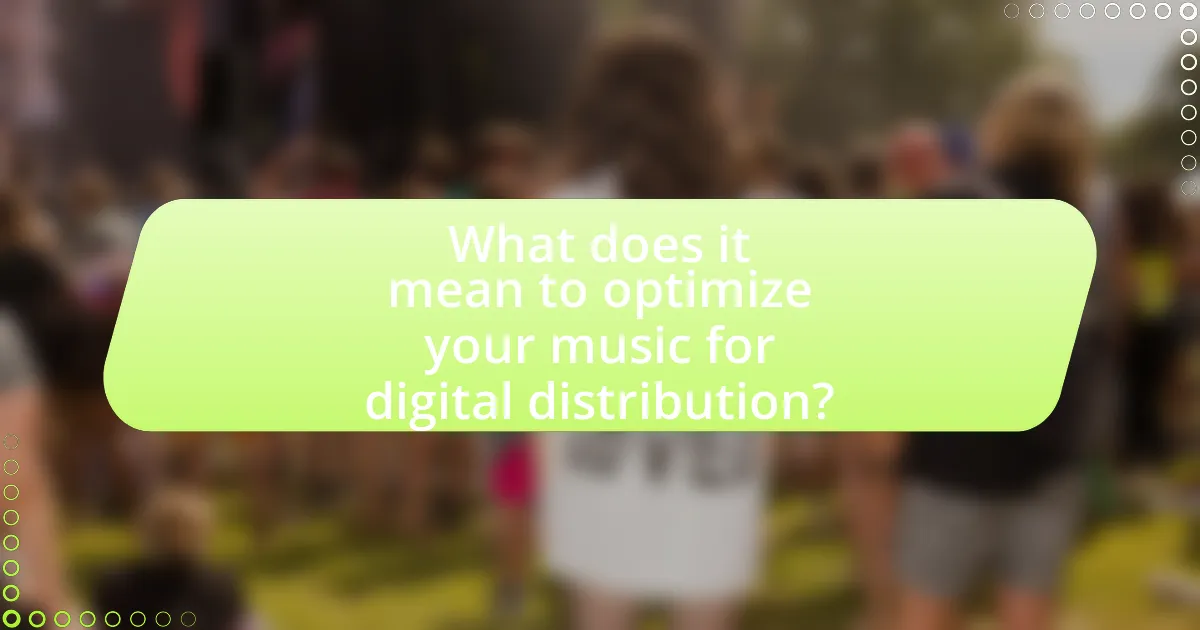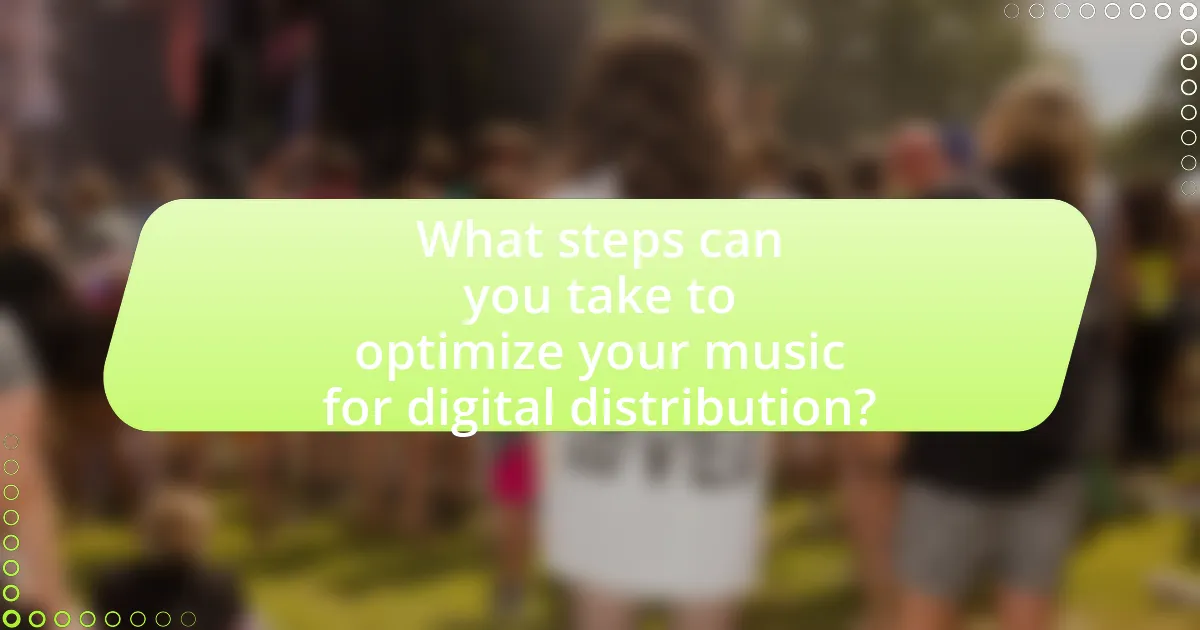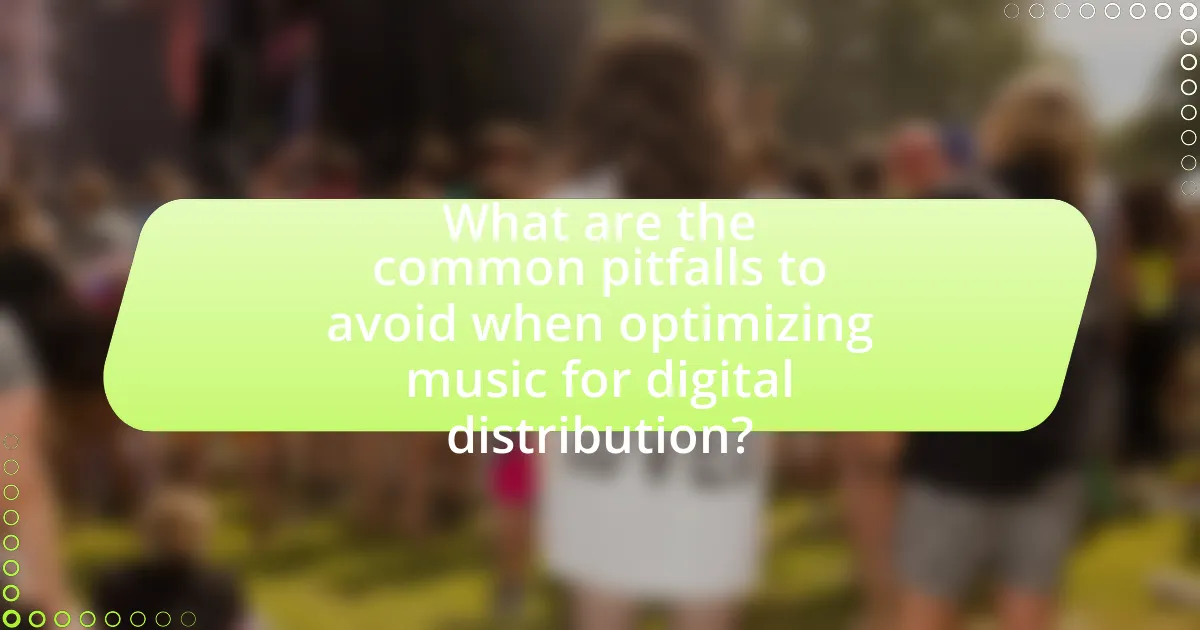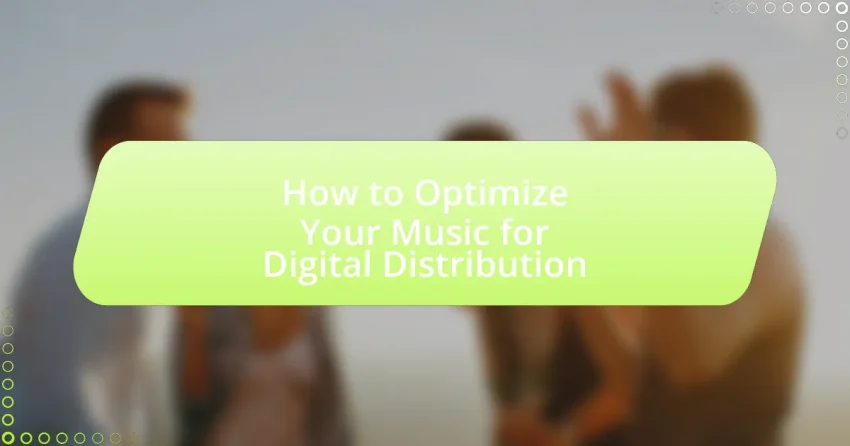The article focuses on optimizing music for digital distribution, emphasizing the importance of high-quality audio files, accurate metadata, and effective branding. It outlines how digital distribution enhances music visibility and the role of key platforms like Spotify and Apple Music in promoting tracks. Additionally, the article discusses the impact of music quality on listener engagement, the significance of mastering, and best practices for promoting music post-distribution. By following these guidelines, artists can improve their chances of success in the competitive digital music landscape.

What does it mean to optimize your music for digital distribution?
Optimizing your music for digital distribution means preparing your audio files and metadata to ensure they meet the technical and quality standards required by digital platforms. This process includes ensuring high-quality audio formats, proper tagging of song information, and compliance with the specifications of distribution services like Spotify or Apple Music. For instance, using lossless formats like WAV or FLAC can enhance sound quality, while accurate metadata, including artist name, album title, and genre, helps in proper categorization and discoverability on streaming platforms.
How does digital distribution impact music visibility?
Digital distribution significantly enhances music visibility by providing artists with access to global platforms where their music can be discovered by a wider audience. This access allows independent musicians to reach listeners without the need for traditional record label support, which historically limited exposure. According to a report by the International Federation of the Phonographic Industry (IFPI), over 70% of music consumption now occurs through digital platforms, illustrating the shift in how audiences engage with music. Furthermore, digital distribution channels like Spotify and Apple Music utilize algorithms that promote tracks based on user preferences, increasing the likelihood of discovery for new artists. This data-driven approach to music promotion underscores the critical role digital distribution plays in enhancing visibility in a crowded marketplace.
What are the key platforms for digital music distribution?
The key platforms for digital music distribution include Spotify, Apple Music, Amazon Music, and YouTube Music. These platforms dominate the digital music landscape, providing artists with extensive reach and access to millions of listeners. For instance, Spotify boasts over 500 million users, making it one of the largest streaming services globally. Apple Music, with its integration into the Apple ecosystem, has over 88 million subscribers, while Amazon Music has rapidly grown to over 100 million users. YouTube Music leverages the vast user base of YouTube, which has over 2 billion monthly active users, allowing artists to promote their music effectively.
How does music optimization influence streaming algorithms?
Music optimization significantly influences streaming algorithms by enhancing the discoverability and ranking of tracks on platforms. When music is optimized, it typically involves improving metadata, audio quality, and engagement metrics, which are critical factors that algorithms use to recommend content to users. For instance, platforms like Spotify utilize algorithms that analyze user behavior, track popularity, and metadata accuracy to curate playlists and suggest songs. Research indicates that tracks with well-optimized metadata, including genre tags and descriptive keywords, are more likely to be featured in algorithmic playlists, leading to increased streams and visibility. Therefore, effective music optimization directly correlates with improved performance within streaming algorithms, ultimately impacting an artist’s reach and success in the digital landscape.
Why is music quality important for digital distribution?
Music quality is crucial for digital distribution because it directly impacts listener engagement and retention. High-quality audio ensures that the music is experienced as intended by the artist, enhancing emotional connection and satisfaction for the audience. Research indicates that listeners are more likely to share and recommend music that sounds professional and polished, which can lead to increased streams and sales. For instance, a study by the International Federation of the Phonographic Industry found that 70% of consumers prefer high-quality audio formats, demonstrating that sound quality influences purchasing decisions. Therefore, maintaining high music quality is essential for maximizing reach and success in the digital marketplace.
What are the recommended audio formats for digital distribution?
The recommended audio formats for digital distribution are WAV, FLAC, and MP3. WAV is a lossless format that provides high-quality audio, making it ideal for professional use. FLAC also offers lossless compression, allowing for smaller file sizes without sacrificing audio quality, which is beneficial for streaming services. MP3 is a widely used lossy format that balances file size and sound quality, making it suitable for general distribution and consumer use. These formats are commonly accepted by major digital distribution platforms, ensuring compatibility and optimal playback across various devices.
How does mastering affect the final sound quality of music?
Mastering significantly enhances the final sound quality of music by ensuring that tracks are polished, balanced, and optimized for playback across various systems. This process involves adjusting levels, equalization, compression, and limiting to create a cohesive sound that translates well on different audio devices. For instance, a well-mastered track will maintain clarity and impact whether played on high-end speakers or standard earbuds, which is crucial for digital distribution where listeners use diverse playback systems. Mastering also addresses issues like dynamic range and frequency balance, ensuring that the music sounds professional and engaging, ultimately leading to a better listener experience.

What steps can you take to optimize your music for digital distribution?
To optimize your music for digital distribution, ensure high-quality audio files, use proper metadata, and select the right distribution platforms. High-quality audio files should be in formats like WAV or FLAC to maintain sound integrity, as platforms often reject lower-quality formats. Proper metadata, including artist name, track title, genre, and album art, enhances discoverability and ensures accurate representation on streaming services. Selecting the right distribution platforms, such as DistroKid or TuneCore, allows for broader reach and better revenue options, as these services distribute to multiple streaming platforms simultaneously.
How can metadata enhance your music’s discoverability?
Metadata enhances your music’s discoverability by providing essential information that helps streaming platforms and search engines categorize and recommend tracks effectively. Accurate metadata, including artist names, song titles, genres, and keywords, allows algorithms to match music with listener preferences, increasing the likelihood of your music appearing in search results and playlists. For instance, a study by the International Federation of the Phonographic Industry (IFPI) indicates that properly tagged music can lead to a 30% increase in streaming visibility. This demonstrates that well-structured metadata is crucial for maximizing audience reach and engagement in the digital music landscape.
What essential metadata should be included with your tracks?
Essential metadata that should be included with your tracks includes the track title, artist name, album name, genre, release date, and track number. This information is crucial for digital distribution as it helps platforms categorize and display music accurately. For instance, including the correct genre allows streaming services to recommend tracks to listeners based on their preferences, enhancing discoverability. Additionally, accurate release dates ensure that music is available to fans at the right time, while track numbers help maintain the intended order of songs in an album.
How does accurate genre tagging affect audience reach?
Accurate genre tagging significantly enhances audience reach by ensuring that music is discoverable by listeners who are specifically interested in that genre. When music is correctly tagged, it aligns with the preferences of targeted audiences, leading to increased visibility on streaming platforms and social media. For instance, a study by Nielsen Music found that 70% of listeners discover new music through genre-based playlists, demonstrating that precise tagging directly influences how often music is recommended to potential fans. This targeted approach not only improves engagement but also fosters a loyal listener base, as audiences are more likely to connect with music that resonates with their tastes.
What role do cover art and branding play in music optimization?
Cover art and branding are crucial in music optimization as they significantly influence listener perception and engagement. Effective cover art captures attention and conveys the essence of the music, making it more likely to be shared and streamed. Research indicates that visually appealing album covers can increase sales and streaming by up to 30%, demonstrating their impact on consumer behavior. Additionally, consistent branding across an artist’s work fosters recognition and loyalty, which are essential for building a fan base in a competitive digital landscape. Therefore, both elements play a vital role in enhancing visibility and driving listener interaction with music.
How can professional cover art impact listener engagement?
Professional cover art significantly enhances listener engagement by creating a visually appealing representation of the music, which can attract potential listeners. Research indicates that 75% of consumers make judgments about a product based on its packaging, and this principle applies to music as well. High-quality cover art can evoke emotions, convey the genre, and establish an artist’s brand identity, leading to increased streaming and purchasing behavior. For instance, a study published in the Journal of Consumer Research found that visually striking album covers can lead to a 20% increase in listener interest and engagement. Thus, professional cover art plays a crucial role in capturing attention and fostering a deeper connection with the audience.
What branding strategies should artists consider for digital platforms?
Artists should consider developing a cohesive visual identity and engaging storytelling as key branding strategies for digital platforms. A cohesive visual identity includes consistent use of colors, fonts, and imagery across all digital assets, which helps in creating brand recognition. Engaging storytelling allows artists to connect emotionally with their audience, enhancing relatability and loyalty. According to a study by the Nielsen Norman Group, users are more likely to engage with brands that tell compelling stories, leading to increased fan interaction and support. Additionally, utilizing social media analytics can help artists tailor their content to audience preferences, further strengthening their brand presence online.

What are the common pitfalls to avoid when optimizing music for digital distribution?
Common pitfalls to avoid when optimizing music for digital distribution include neglecting proper metadata, failing to ensure high-quality audio files, and overlooking the importance of cover art. Neglecting proper metadata can lead to misidentification of tracks, which affects discoverability on platforms; accurate metadata is essential for search optimization. Failing to ensure high-quality audio files can result in poor listening experiences, as streaming services often have specific requirements for file formats and bitrates. Overlooking the importance of cover art can diminish the visual appeal of music releases, as platforms often prioritize visually engaging content, impacting listener engagement and sales.
How can poor quality recordings affect your music’s success?
Poor quality recordings can significantly hinder your music’s success by diminishing listener engagement and reducing the likelihood of playlist placements. When audio quality is subpar, it can lead to negative perceptions among potential fans and industry professionals, as high-quality production is often associated with professionalism and credibility. Research indicates that 70% of listeners will abandon a song within the first 30 seconds if the sound quality is poor, which directly impacts streaming numbers and overall reach. Additionally, platforms like Spotify prioritize high-quality tracks for their curated playlists, meaning that poor recordings may not even be considered for promotion, further limiting exposure and growth opportunities.
What are the consequences of neglecting proper mastering?
Neglecting proper mastering can lead to a significant decline in audio quality, resulting in a less professional sound that may alienate listeners. Poorly mastered tracks often suffer from imbalanced frequencies, inadequate loudness levels, and a lack of clarity, which can diminish the overall impact of the music. For instance, a study by the Audio Engineering Society highlights that tracks lacking proper mastering can lose up to 30% of their perceived loudness, making them less competitive in digital distribution platforms where loudness is a critical factor for listener engagement. Additionally, unmastered tracks may not translate well across different playback systems, leading to a subpar listening experience that can harm an artist’s reputation and sales potential.
How does inconsistent branding confuse potential listeners?
Inconsistent branding confuses potential listeners by creating ambiguity about the identity and message of the music. When branding elements such as logos, color schemes, and promotional materials vary significantly, listeners may struggle to associate the music with a specific artist or genre. This confusion can lead to a lack of recognition and trust, ultimately diminishing the likelihood of engagement or loyalty. Research indicates that consistent branding can increase customer recognition by up to 80%, highlighting the importance of uniformity in establishing a clear and memorable presence in the digital music landscape.
What are the best practices for promoting your music after distribution?
The best practices for promoting your music after distribution include leveraging social media, engaging with fans, utilizing email marketing, and collaborating with influencers. Social media platforms like Instagram, Facebook, and TikTok allow artists to share content, connect with audiences, and promote new releases effectively. Engaging with fans through live streams, Q&A sessions, and responding to comments fosters a loyal community. Email marketing enables direct communication with listeners, providing updates and exclusive content, which can increase engagement and sales. Collaborating with influencers can expand reach, as they often have established audiences that trust their recommendations. According to a 2021 report by the International Federation of the Phonographic Industry, social media and influencer marketing are among the top strategies for music promotion, highlighting their effectiveness in reaching wider audiences.
How can social media be leveraged for music promotion?
Social media can be leveraged for music promotion by utilizing platforms to engage with audiences, share content, and build a fanbase. Artists can create profiles on platforms like Instagram, Facebook, and TikTok to post updates, behind-the-scenes content, and snippets of new music, which fosters a connection with fans. According to a 2021 report by the International Federation of the Phonographic Industry, 75% of music consumers discover new music through social media, highlighting its effectiveness in reaching potential listeners. Additionally, targeted advertising on these platforms allows artists to reach specific demographics, further enhancing their promotional efforts.
What strategies can help in building a loyal fanbase online?
To build a loyal fanbase online, engaging consistently with your audience through authentic communication and valuable content is essential. This strategy fosters trust and connection, which are critical for loyalty. Research indicates that brands that engage with their audience on social media see a 20-40% increase in customer loyalty (source: Bain & Company). Additionally, offering exclusive content, such as behind-the-scenes access or early releases, can enhance fan engagement and retention. According to a study by the Content Marketing Institute, 70% of consumers prefer to learn about a company through articles rather than ads, highlighting the importance of providing valuable content to maintain interest and loyalty.
What practical tips can you implement for effective music optimization?
To effectively optimize music for digital distribution, focus on high-quality audio files, proper metadata tagging, and strategic release planning. High-quality audio files should be in formats like WAV or FLAC to ensure clarity and fidelity, as platforms often prioritize sound quality. Proper metadata tagging, including accurate song titles, artist names, and genre classifications, enhances discoverability on streaming services and helps algorithms categorize the music correctly. Strategic release planning, such as timing releases to coincide with promotional efforts or significant dates, can increase visibility and engagement. These practices are supported by industry standards that emphasize the importance of quality and organization in digital music distribution.
